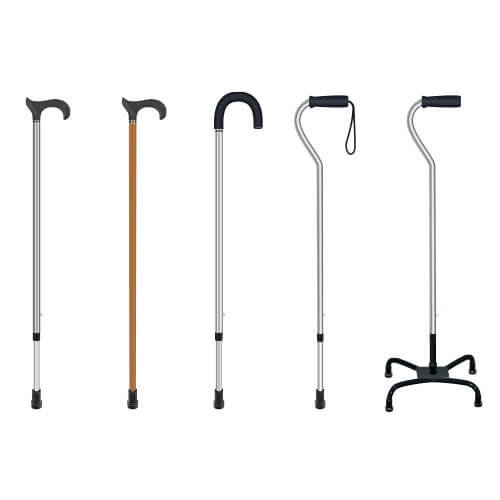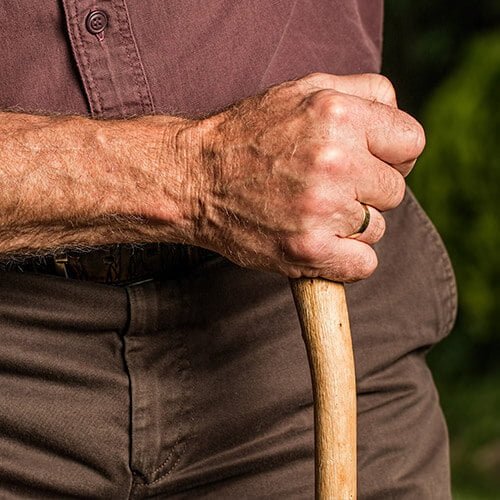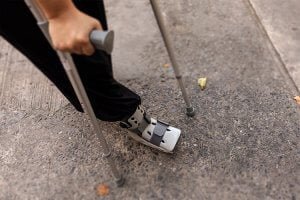- Sticks, Canes & Crutches
- Our Quality Guarantee
- Last Updated January 18, 2024

What Is The Difference Between a Walking Stick and a Cane?
People who suffer from disabilities or injuries, in particular, the elderly and those at risk of falling, are often advised by medical experts to use mobility aids. There are a wide range of mobility devices a person can choose from, but two popular, non-intrusive, and simple types are walking sticks and canes. However, these devices are relatively similar, and this begs the question: What is the difference between a walking stick and a cane?
In short, the fundamental difference between a walking stick and a cane is their function. Walking sticks are a temporary device primarily used for stability and balance when climbing or walking on rough terrains. In contrast, walking canes are mobility aids designed to take the pressure off a painful joint on a long-term basis.
Despite these differences, both devices provide numerous benefits to those who are prone to falling and injuring themselves. They provide independence and mobility for the user without them having to depend on anyone to assist them – also making them an excellent boost for self-esteem and confidence.
However, it can often be challenging to decide which aid is the best type for you. So, in this article, we provide in-depth analysis and comparison of walking sticks vs canes to help you understand and choose the best mobility device for your needs.
In This Article
Walking Stick vs Walking Canes Comparison
Walking Cane Overview

Walking canes serve a purpose similar to crutches; they provide support for a user’s body-weight. Canes transfer your weight from your legs to your upper-body, making mobility easier. When used properly, they reduce pressure on the legs, instead of placing it on the arms and wrists.
It is estimated that 1 in 10 adults over the age of 65 years in the USA uses a cane to assist in getting around – so they’re a fairly popular device with the elderly for use on a long-term basis.
Perhaps one reason for this high level of use is that there are many different types of canes to choose from, all offering slightly different benefits:
- Quad Canes
Quad canes (also known as 4-prong canes) provide for great stability and balance as they consist of four feet at the base of the cane to distribute a user’s weight. - Forearm Canes
Forearm canes are a type of cane that, as their name suggests, offer support to the forearm to distribute the pressure from the wrist to the arm. - Adjustable Canes
Adjustable canes are a type of cane that can be adjusted according to the user’s height and sometimes may even be foldable. They usually provide less stability in exchange for greater flexibility.
Walking Stick Overview

Walking sticks are perhaps better classified as accessories rather than mobility aids, although they do still have some level of usefulness. Walking sticks are most commonly used temporarily, during certain activities such as hiking. They are not designed to bear a person’s full body-weight, and usually, the handles are shaped in a way that makes it uncomfortable to rely on them fully.
The Key Differences
So, the key differences between walking sticks and walking canes are in their functionality and practicality. Whilst a cane is recommended as a long-term mobility aid, a walking stick fulfills the purpose of a walking accessory or occasional support. Canes are longer-lasting, more comfortable, and safer than walking sticks for use on a long-term basis.
How to Choose Between a Walking Stick or Cane
When selecting the right kind of mobility aid for you, you must ensure that it serves the purpose it is purchased for. Here are some essential factors to consider when making a decision:
How Much Balance Support do You Need?
If you need a device to help you balance and provide support on a day-to-day basis, a cane is the better option. They are specifically designed for this purpose and suit it well. However, if you merely need a device to use when walking on trails, hiking, or for primarily aesthetic purposes, a walking stick might be a better option.
How Much do You Weigh?
Walking sticks are not designed to take much weight, whereas canes are specifically designed with weight capacities to ensure they can provide full support to users. If you are on the heavier side and want a mobility aid that can genuinely provide support, a cane is a better option.
Do You Want Comfort or Style?
Many people use the assistance of a mobility aid because they fear that they may fall over and injure themselves; this includes the elderly or those who have less strength in their lower body. If these are genuine concerns for you, a cane is a better option. They are comfortable and designed for these purposes.
However, if you want a device that looks good, can provide some level of support and comfort, and can offer some peace of mind during certain strenuous activities – a walking stick should be able to get the job done.
Final Note: Picking the Right Walking Aid for You
While we have provided some general advice above, everyone’s circumstances and needs and different.
For example, a great walking stick or cane for a man is unlikely to be a great walking stick or cane for a woman. These devices are manufactured, keeping in mind the differences between the height and weight of both genders.
As men are likely to have larger hands than women, the best device for a man is expected to have a more spacious handle. Also, men may be better suited to heavier walking stick or cane that can offer support for a higher body-weight.
In contrast, walking aids for women should generally be comparatively more slender, with less spacious handles, and of a lighter weight. Of course, these are generalizations and meant to emphasize that every user will have specific, personal circumstances.
Despite this, typically, walking sticks serve the purpose of providing minor support as an accessory and should not be purchased as a primary source of mobility support. Canes, on the other hand, are manufactured in various heights, weight, and shapes, to meet the serious mobility, balance, and comfort needs of those that need them.
Articles You May be Interested In:


















